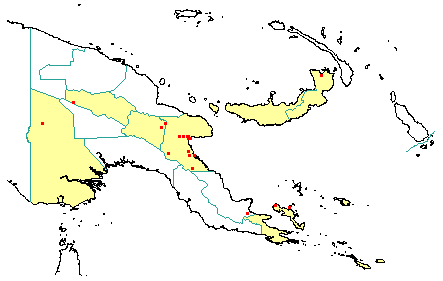
in PNGplants database
PNGTreesKey – Calophyllum papuanum Lauterb. |
Barry Conn (NSW) & Kipiro Damas (LAE).
Guide to trees of Papua New Guinea
Copyright held by the authors, National Herbarium of New South Wales, and Papua New Guinea National Herbarium
Botanische Jahrbucher für Systematik, Pflanzengeschichte und Pflanzengeographie Vol. 58: 9 (1922) Fig. 2.
Other Literature: P.F. Stevens, Handbooks of the Flora of Papua New Guinea 90-91 (1995)
Family: Clusiaceae
Dicotyledon
Timber Group: Major exportable hardwood
Field Characters: Large canopy tree (up to 40 m high) or Small sub-canopy tree (mostly 10-25 m high); Bole cylindrical (up to c. 100 cm diam.); straight (bole 10-20 m long); buttresses buttresses present (sometimes buttresses up to 3 m high) or buttresses absent (sometimes with spurs at base); spines spines absent; aerial roots aerial roots absent; stilt roots stilt roots absent; Bark dark grey or brown, rough, scaly or flaky or fissured; Subrhytidome (under-bark) pink or dark red; less than 25 mm thick, 10.0-15.0; bark blaze consisting of one layer; strongly aromatic; pleasant; outer blaze red, markings absent, fibrous; inner blaze red, markings absent, fibrous; bark exudate (sap) present, very light yellow, not readily flowing (spotty), colour changing on exposure to air, to orange or brown, sticky; terminal buds not enclosed by leaves.
Indumentum: Complex hairs present, star-like (stellate); stinging hairs absent; mature twig indumentum (hairs) present, hairs dense to sparse.
Leaves: Leaves clustered at end of branches, opposite (in pairs, opposite one another on the branchlet), simple (a leaf composed of a single blade); petiole present, not winged, attached to base of leaf blade, not swollen; leaves broadest at or near middle, (2.4-) 6.5-17.0 (-22.0) cm, (1.4-) 3.5-8.0 (-11.0) cm; symmetric, entire, not dissected or lobed, rounded or sub acute, venation pinnate, secondary veins closed, prominent or not prominent, but visible, intramarginal veins absent; leaves lower surface green, upper surface dark green (sub-glossy), indumentum (hairs) present (hairs usually persistent on lower surface), indumentum (hairs) dense or sparse; absent; domatia absent; stipules absent.
Flowers: Inflorescence axillary, usually flowers on an unbranched axis, cones absent; flowers unisexual, unisexual probably with male and female flowers on different plants, stalked, flowers with many planes of symmetry, 4.5-9.0 mm long, diameter small (up to10 mm diam.) (4.5-9 mm diam.); perianth present, with all sepals and/or petals (hence tepals) similar, inner perianth white; usually 8, free; stamens (70-) 150-300, present, free of each other, free of the perianth; ovary superior, carpels joined (when more than one), locules 1; styles solitary, 1.
Fruits: Infrutescence usually arranged on unbranched axis, fruit 20.0-50.0 mm long, 40.0-45.0 mm diam., brown, not spiny, non-fleshy, simple, indehiscent, drupe; seeds 1, much more than 10 mm long, not winged, broad (as wide as long), seed more than 10 mm diam.
Distribution: Morobe, Western Highlands, Eastern Highlands, Western, Milne Bay, Papuan Islands & New Britain.
 | Botanical records in PNGplants database |
Notes: Notes Often included in the family Guttiferae.